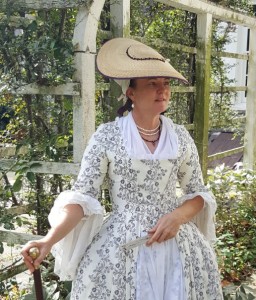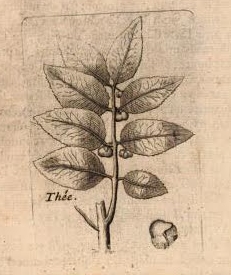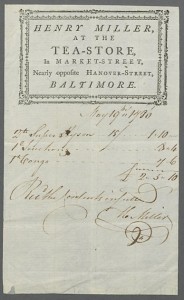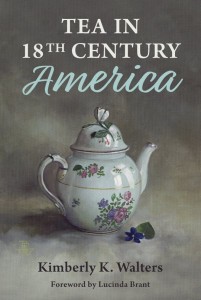Historical nonfiction author Kimberly Walters provides a window into the social and political life of 18th-century America—via tea.
###
 Relevant History welcomes back nonfiction author Kimberly K. Walters, who started reenacting as a hearth cook in 2009 as the Washington Headquarters housekeeper, modeled after Mrs. Elizabeth Thompson. A Book of Cookery by a Lady (2014) is a tribute to Mrs. Thompson. An avid horse woman, animal lover, and historian, Kim is a member of the Fincastle Chapter, the National Society Daughters of the American Revolution in Kentucky. At K. Walters at the Sign of the Gray Horse, she sells reproduction and historically inspired jewelry to care for her rescued and Colonial Williamsburg retired horses. Tea in 18th Century America was released on 17 July 2019. To learn more about her and her books, visit her web site, and follow her on Facebook, Twitter, and Instagram.
Relevant History welcomes back nonfiction author Kimberly K. Walters, who started reenacting as a hearth cook in 2009 as the Washington Headquarters housekeeper, modeled after Mrs. Elizabeth Thompson. A Book of Cookery by a Lady (2014) is a tribute to Mrs. Thompson. An avid horse woman, animal lover, and historian, Kim is a member of the Fincastle Chapter, the National Society Daughters of the American Revolution in Kentucky. At K. Walters at the Sign of the Gray Horse, she sells reproduction and historically inspired jewelry to care for her rescued and Colonial Williamsburg retired horses. Tea in 18th Century America was released on 17 July 2019. To learn more about her and her books, visit her web site, and follow her on Facebook, Twitter, and Instagram.
*****
Tea in 18th Century America focuses on the beverage in the American colonies during the eighteenth century. The only other person to write about this topic was Rodris Roth in the 1960s. Tea in 18th Century America is an expansion of a chapter of A Book of Cookery by a Lady, published in 2014.
 In America, tea was much more than just a drink, and the book gives the reader insight into the importance of tea in the Colonies and early Federal eras. The book begins with an introduction to the history of tea, its journey to the shores of America tracing its ebbs and flows in popularity, and the cultural meaning attached to its use. Then, while giving credit to the research done by Rodris Roth, I added extensive research utilizing period newspapers, historic texts, period portraits, and prints to immerse the reader in their world.
In America, tea was much more than just a drink, and the book gives the reader insight into the importance of tea in the Colonies and early Federal eras. The book begins with an introduction to the history of tea, its journey to the shores of America tracing its ebbs and flows in popularity, and the cultural meaning attached to its use. Then, while giving credit to the research done by Rodris Roth, I added extensive research utilizing period newspapers, historic texts, period portraits, and prints to immerse the reader in their world.
 Tea in pre- and post-revolutionary America was a symbol of tyranny or patriotism and helped create an American identity. At first, I did not want to go in-depth on the explanation of the legal acts and taxes on commodities that set the stage for Americans’ outrage over the monopoly held by the East India Tea Company on tea. However, I felt it an essential and necessary part of this story. The acts and taxes led to the drop in popularity of tea as revolutionary sentiments grew. To drink tea became a political act, although that seemed only to be the case for imported tea. The tea ceremony was still being practiced, albeit with herbal tea as a substitute. Also tea was still being ordered for import, but we do not know if it ever made it to those who ordered it.
Tea in pre- and post-revolutionary America was a symbol of tyranny or patriotism and helped create an American identity. At first, I did not want to go in-depth on the explanation of the legal acts and taxes on commodities that set the stage for Americans’ outrage over the monopoly held by the East India Tea Company on tea. However, I felt it an essential and necessary part of this story. The acts and taxes led to the drop in popularity of tea as revolutionary sentiments grew. To drink tea became a political act, although that seemed only to be the case for imported tea. The tea ceremony was still being practiced, albeit with herbal tea as a substitute. Also tea was still being ordered for import, but we do not know if it ever made it to those who ordered it.
Enjoying tea required all types of “material culture” items: teapots, spoons, tea chests, cups, saucers, slop bowls, specialized spoons such as “mote spoon” and “tea scoop” specifically for the tea caddy, and various other items that were markers of class and financial status. Taking tea was often a performative act in social settings, with rules to be followed and customs to be learned. Tea was so much more than a delightful hot beverage, and it was not only “taken” with sweets as a side dish.
I included chapters on when during the day people in eighteenth-century America drank tea, and the types that were popular. There are instructions on understanding eighteenth-century recipes as well as identifying foods that are perfect to prepare and eat when having your own tea party. From breads and small cakes to dessert collations—there are notes for each recipe to help prepare them. I have also included descriptions of how food was given color and even how medicinal teas were used to cure an ill.
A bonus chapter focuses on the life of Margaret Tilghman Carroll, widow of Charles Carroll “the Barrister.” While living at Mount Clare in Baltimore, Maryland, Mrs. Carroll kept an account book that included an inventory on tea items she owned, and she wrote recipes within it. That book is preserved in the Maryland Historical Society library.
*****
 A big thanks to Kimberly Walters! She’ll give away one hardcover copy of Tea in 18th Century America to someone who contributes a comment on my blog this week. I’ll choose the winner from among those who comment by Friday at 6 p.m. ET. Delivery is available worldwide.
A big thanks to Kimberly Walters! She’ll give away one hardcover copy of Tea in 18th Century America to someone who contributes a comment on my blog this week. I’ll choose the winner from among those who comment by Friday at 6 p.m. ET. Delivery is available worldwide.
**********
Did you like what you read? Learn about downloads, discounts, and special offers from Relevant History authors and Suzanne Adair. Join Suzanne Adair’s Patreon, and subscribe to her free newsletter.
